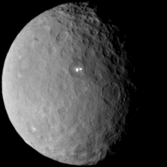
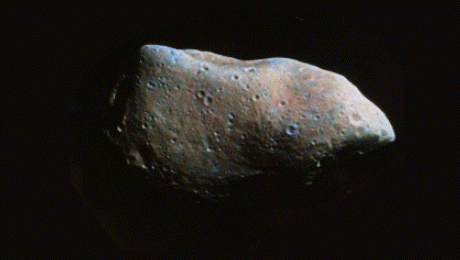
Dawn Spacecraft takes a picture of Ceres (notice the mysterious bright spots ... likely salt deposits). Asteroid Gaspra (Credit NASA) taken by the probe Galileo
Space stuff slams into the Earth every day .... making more Earth. Some of these objects are solid and some are made of ice. They come in all shapes and sizes. The bigger they are, the bigger the news headlines. Where does this stuff come from? Simple answer - from right here!!! They have been floating around for 4.6 billion years and finally found us. Our solar system is loaded with debris. The bigger things we call asteroids and comets.
As stated in the overview, most of the asteroids are irregular in shape and orbit the sun between the orbits of Mars and Jupiter. Asteroids are rocky and/or metal solid objects (with little or no ice). Close up images of Gaspra, Ida, and Eros show a heavily cratered surface. A few asteroids orbit farther from the sun (near Saturn and Uranus) and are known as Centaurs. Some orbit near the terrestrial planets (known as Near Earth Objects) and pose a potential threat to us if they were to hit Earth.


Dawn Spacecraft takes a picture of Ceres (notice the mysterious bright spots ...
likely salt deposits).
Asteroid Gaspra (Credit NASA) taken by the probe Galileo
The first asteroid discovered (1801) was also the largest, Ceres, which is about 600 miles in diameter (which has since been promoted to dwarf planet status). We have some great pictures when the Dawn spacecraft reached Ceres in 2015. Think of Ceres during your next breakfast and have a bowl of cereal (both named for the Roman goddess of grain). Soon after the discovery of Ceres, several more large asteroids were found which measured between 250 and 325 miles in diameter. The Dawn craft orbited (2011-2012) Vesta and took some great pictures. As astronomers continued to look, more and more smaller ones were found. Early astronomers initially believed that asteroids were the broken fragments of a destroyed world (have you ever heard the story of Superman and his native planet Krypton?). Modern astronomers now believe that the entire solar system looked much like the asteroid belt. However, in other regions of the solar system, these smaller objects coalesced to form planets, but the asteroid belt never did take that next step. However, it is not a mystery why. Massive Jupiter is able to exert enough of an influence on asteroids ... applying perturbing gravitational tidal forces on these smaller objects, which prevent them from grouping into a larger object. It is also these perturbing forces which make it possible for some asteroids to be ejected from the belt into Earth crossing orbits.
Ceres Update: Analysis of data from the Dawn spacecraft suggest that Ceres may harbor a subsurface ocean of liquid water! Not everyone is convinced. This adds Ceres to the list of smaller rocky bodies to potentially hold underground bodies of water. This makes the search for extraterrestrial life within our own solar system much more interesting. Ceres is relatively close, making it a much easier target for future missions.
Interstellar Guests: The year 2017 gave us a rare treat. It was the first time (that we know of) where our solar system was visited by an asteroid from interstellar space. Named Oumuamua, this asteroid entered our solar system from a strange direction (far from the plane of the ecliptic), speed (with escape velocity), and orbit (hyperbolic). It showed no signs of dust which ruled out a comet. The thing that was very unusual about the path of this visitor was that it varied in its orbit in ways gravity could NOT account for. This led some to believe it was a self propelled spaceship! Not to worry, it was not ET. Subsequent studies suggest that deeply buried ice sublimated into space when Oumuamua approached the warmth of the sun, which acted like rocket engines to alter its path. It varied greatly in brightness leading astronomers to conclude that it was cigar shaped. It is now heading out of the solar system. Objects like this could be one possible way life (microbes) may hitchhike from one star system to another. More here. Update: It happened again in 2019 so now we know of two visitors from outside our solar system but their place of origin is still a mystery. Update Again: In 2025 we now have discovered the third interstellar object - comet 3I/Atlas. There will be more so maybe I can stop counting. The interesting thing is discovering that these visitors from other solar systems tell us their chemical makeup and tell us systems like ours may be very common. Who knows ... maybe this way would be the easiest and cheapest way for ET to hitch a ride from one solar system to another???
Asteroids vary in composition. A lot depends on where they formed and evolved since their formation. As stated before, asteroids represent a sample of the very early stages of our solar system. The asteroids closer to the sun vary from the ones further out. Generally speaking, asteroids closer to the sun contain more carbon and as you move further from the sun, the main ingredient shifts to silicates (silicon and oxygen ... the same stuff that makes up the earth's crust and mantle). There are even a few asteroids make mostly of metal (iron and nickel). These are believed to be the exposed core of body that was once much larger, differentiated, and then blown to pieces by a later collision. Click here to learn more about the composition of asteroids. The early asteroid belt show a very violent history!
The connection between
meteorites and asteroids
Nearly all the rocky stuff that hits Earth now (meteorites) originally came from the asteroid belt (and a few from the Moon and Mars). Below is an image showing the distribution of asteroids in the asteroid belt.
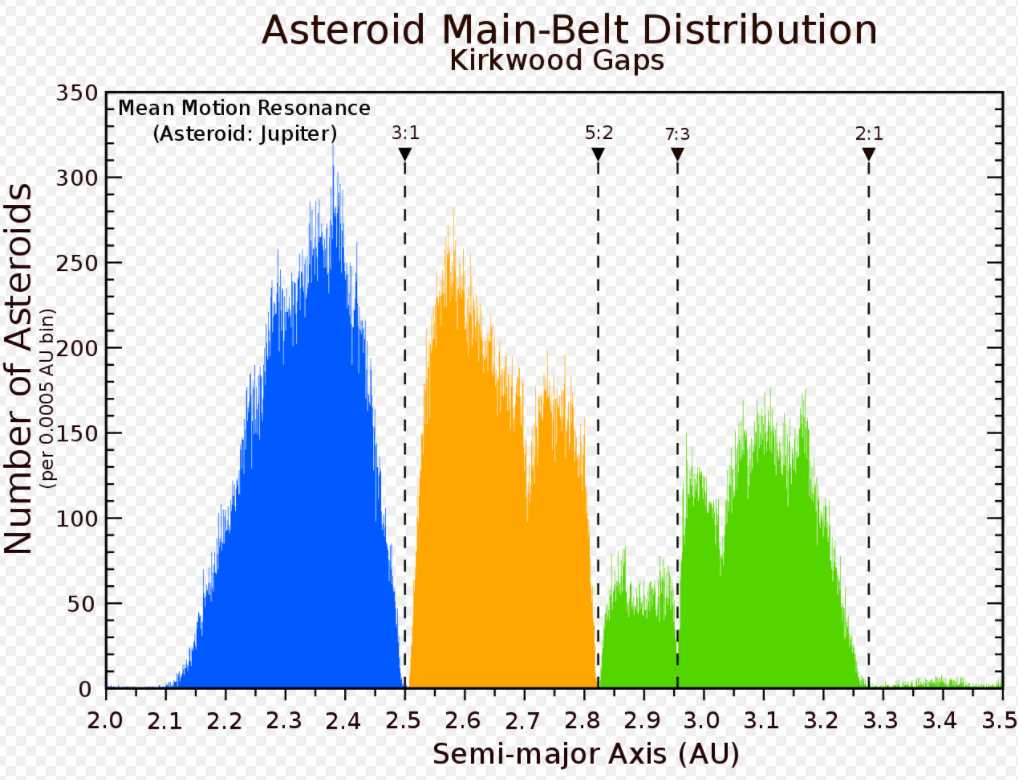
Courtesy Wikipedia commons
You will notice distinct "gaps" in this distribution (known as Kirkwood Gaps). These are the "escape hatches" which allow chunks of asteroids to move from the asteroid belt to an orbit closer to Earth. The orbit of Jupiter is mainly responsible for these gaps because (for example) the gap labeled 3:1 at a distance of 2.5 AU means for every time Jupiter makes ONE orbit around the sun (at 5.2 AU) asteroids in this gap make THREE orbits around the sun (at 2.5 AU). These "resonance zones" are gravitationally unstable for poor asteroids that might wonder in there and as a result, are perturbed into orbits with higher and higher eccentricities until they encounter a planet like Earth. At that time, their orbits are completely changed again and become potential "Earth crossing" asteroids. This works for stuff of any sizes but it is generally much easier to nudge smaller stuff into the Kirkwood Gaps than it is to move bigger stuff. As a result of all this, we have a delivery system to move stuff from there (asteroid belt) to here (Earth). I had the privilege of taking a course from Dr. Michael Gaffey (a renowned astrophysicist) who spent his entire career trying to match meteorite types to the asteroid parent body they were knocked off of (via ejection collisions). Of the 135 known unique types of meteorites in the collection, only 4 have been matched to their asteroid parent body. There is lots of work left in that field. Once that is done, we will have a very good idea of the conditions (temperature, pressure, chemical composition, density) of the early solar system at a specific place and time.
When a chunk of space rock enters our atmosphere as a burst of light, we call it a meteor (or meteorite once it lands). Think of these rocks as pieces of asteroids being delivered to us. Upon examination, one thing scientists have found in these rocks are amino acids! These are the building blocks of life!!!! Could we thank asteroids (and comets) for seeding a very young Earth with the ingredients to make life???
Asteroid Sample Return Missions
Samples of the asteroid belt occur every time a meteorite hits the ground, but it is a bit of a guessing game to determine the exact place in the asteroid belt they initially formed. One way to resolve that is to go out, collect a sample, and return it to Earth. This was first done by the Hayabusa probe (Japan) which returned a sample (in 2010) of an asteroid, but the collecting device malfunctioned and only brought back a few micrograms of material. Let's hope Hayabusa2 has better luck when it returns in late 2020. The US's OSIRIS-REx probe successfully landed and collected material from asteroid Bennu in the fall of 2020, and successfully returned it to Earth in 2023.
Update: In June 2022, results of the Hayabusa2 sample were announced. The probe collected 5.4 grams of a "rubble pile" asteroid named Ryugu which were not exposed to cosmic rays or sunlight. This pristine sample revealed the presence of 20 amino acids (the building blocks of proteins)!!! Amino acids have been detected in meteorites long ago but it was not sure if they were "contaminated" when entering our atmosphere of when resting on the earth's surface for some time. This finding confirms that space may have delivered the building blocks of life to Earth. This is big news. Read more here.
Trojan Asteroids - Asteroids can also get captured in a planet's Lagrangian point (we talked about Lagrange points in unit 3 - professional telescopes). It has long been known that Jupiter has a flock of asteroids that both follow and lag in its orbit by 60 degrees. These were drifting asteroids that were trapped in the gravity well of massive Jupiter's L4 & L5 Lagrange points. However, Jupiter is not the only planet that captured asteroids at a Lagrange point ... including Earth. In 2020, a second asteroid was discovered at the earth's L4 Lagrange point. It is likely more will be found in the future.
Credit NASA (Click on the image for a closer look)
Imagine a block of ice the size of a mountain. Now mix in a little dirt and put it in deep space. You just made a comet. Over 6,600 comets have been catalogued (2019), and about 800 (as of 2020) of them are comets which have short period orbits (like Halley's Comet which returns every 76 years). Each year a few new comets are discovered and each year some expected comets fail to return. Some have been observed breaking into several pieces, some crash directly into the sun and we even saw one crash into Jupiter in 1994. In 1997, we were treated to a spectacular show in the form of Hale-Bopp (I hope you had a chance to see it). On the other hand, we were all disappointed when comet ISON failed to make it around the sun in 2013.
Comets have highly eccentric orbits and enter the inner solar system from any direction in space. As a comet enters the inner solar system, the warmth of the sun sublimates some of the frozen gasses, and the comet forms a fuzzy atmosphere called a coma. It can become as big as Earth (remember the solid nucleus is only the size of a mountain). Even closer to the sun, the comet forms a tail as the solar wind blows coma gasses away. For that reason, the tail always points away from the sun regardless which direction the comet is moving. From closer inspection, there are actually two tails. A white/yellowish dust tail (most predominant) composed of small solids (size of smoke dust) that flake off (called a dust tail) and a fainter blue ion tail composed of plasma (gasses) which are ejected from the comet by the vaporization of ices. After the comet reached perihelion, it moves back to cold space where the tail and coma eventually fade away. How a comet is able to make several passes around the sun was always a big question astronomers were unable to answer. That is, until spacecraft took close-up pictures of Halley's Comet in 1986. Astronomers were amazed to find a very dark surface. Apparently, when a comet makes a close approach to the sun, solids mixed within the ice remain, forming a dark insulating surface. A similar effect can be observed in snow piles (if you live in Wisconsin). As spring approaches, and much of the snow melts, the snow pile becomes very dirty as solids become exposed to the surface.
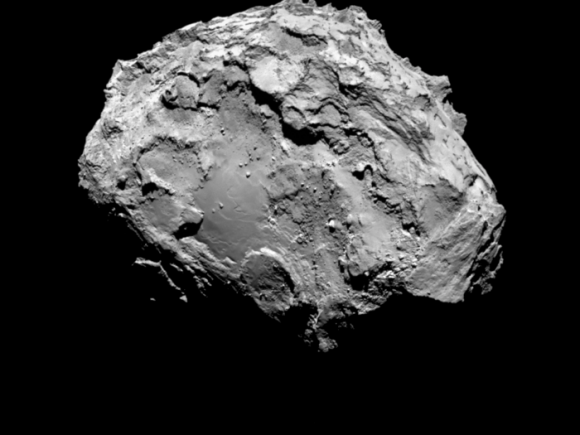
Credit: ESA/Rosetta/MPS for OSIRIS Team MPS/UPD/LAM/IAA/SSO/INTA/UPM/DASP/IDA
This is the best image (to date) of a comet. It was taken August 3, 2014 of Comet 67P/Churyumov-Gerasimenko by ESA's Rosetta spacecraft. The craft released a probe (named Philae) which soft landed on this comet in November, 2014 .... a first in astronomy. One big dirty snowball! Analysis of the data shows this comet has a layered structure with a thin rigid outer layer 10 - 50 cm thick with a less rigid interior. This is consistent with previously held thoughts.
An early astronomer, Jan Oort, wondered where comets come from. He knew they approached the inner solar system with orbits that suggest a great distance. He reasoned that some mechanism must be responsible for the new comets we see entering the inner solar system each year. Working backwards, he determined that if comets reside in a shell with a radius that approached interstellar distances, gravitational perturbations from nearby stars would be enough to knock a few into new orbits, ... producing the new comets we see. The model works well, at least enough to convince fellow astronomers that he was correct. In his honor, the Oort comet cloud is the expected origin of comets. It is unlikely that astronomers will actually be able to see such small objects at such great distances, so we will have to accept the model without direct observational verification. In this 2018 update, astronomers believe they may soon discover Oort clouds around other stars. If so, this would make astronomers very confident there is, indeed, an Oort cloud around our sun.
Even if the comet cloud actually exists, it is unlikely that comets formed there from the start. Computer models suggest that icy planetesimals (comets) formed in the region of the Jovian planets and were either collected together when those giant planets formed or propelled to the comet cloud as they were perturbed by the gravity of Jupiter. You can think of comets as cosmic "pin balls", which are first perturbed by Jupiter to the outer reaches of the solar system. Then nearby stars ping them back towards the sun.
Another place comets come from is the Kuiper Belt. Most short period comets (period <200 yrs) which orbit near the ecliptic plane likely originated from the Kuiper belt. They get perturbed out of the Kuiper Belt by gravitational tugs from nearby Neptune. However, the vast majority of long period comets (>200 yrs) originate from the Oort cloud ... especially if their orbital inclination is far from the ecliptic. No matter what the source, the orbits of comets are very fragile. All you need is another gravitational encounter with Jupiter (or any planet), and their orbit is altered again. Some astronomers believe that many of the near Earth objects (see below) are corpses of burned out comets.
The Earth becomes a target for these projectiles. We have been hit by comets in the past, and in the process, they brought in large quantities of water (and maybe even the chemicals necessary for life). Think about this the next time you take a shower. Speaking of showers, the next time you see a meteor shower, think of comets. The Perseid meteor shower (Aug 10-12) comes each year as Earth slams into debris left behind from comet Swift-Tuttle. Feel fortunate that we run into the material which flaked off the comet and not the comet itself. If that happens now, .... well ... good luck. Just a side note: There are NO meteorites in the collection from comets. Comets come in so fast that anything big enough to break off a comet and come our way will vaporize in the atmosphere well before hitting the Earth's surface. Meteorites come from asteroids.
More information here.
Origin of our water (update 2014)
A quick analysis of the water from Comet 67P showed that it is unlike the composition of the water we find on our planet. It contains three times the deuterium (heavy water) we currently find in our oceans. This tosses a monkey wrench into earlier thought that much of our water came from comets. Researchers have concluded that much of our water was here from the very beginning ... from the meteors and asteroids that were the original building blocks of our planet. How is this possible? Rocky meteorites (of the class carbonaceous chondrite) are believed to have originally formed further from the sun (asteroid belt or beyond). Through time and nudged by gravitational interactions with Jupiter, some found their way to our planet. Analysis of these rocks currently hitting our planet (meteorites) show they contain anywhere from 3%-22% water in their chemical composition (hydrogen and oxygen tied up chemically within the rocks). All you need to do is heat it and water is released. This water has a much lower concentration of deuterium and forces astronomers to suspect that this is the major source of our oceans. This is still debated by scientists and a consensus among experts is far from complete.
Just to keep you updated, in 2020 a study suggests our water came from asteroids.
On occasion, the Earth has a rendezvous with something from space.
Little stuff ...
The debris from comets is typically very small. When we see a typical meteor, it quickly burns up in the upper atmosphere because it is only the size of a piece of gravel .... or smaller. No big deal!
Sometimes a small rock falls to Earth and makes the news. As the rock contacts the atmosphere, we see a streak of light which lasts a second, and we call it a meteor (not a shooting star). These fragments never make it to the ground and burn into ashes about 80 miles above the surface of Earth. The original size is surprisingly small, only about the size of a pea or even smaller. If it moves across the entire sky and/or seen across several states, it is called a fireball. The original rock may fragment and may even reach the ground. If it does, it is called a meteorite. Meteorites are classified by their composition. They are Stony Meteorites (also known as Chondrites) and they make up the majority of all meteorites. Iron meteorites make up about 20% of all meteorites and even rarer (1%) are stony-iron meteorites which are a mixture of stone and iron. You can think stony meteorites as material similar to the earth's mantle and crust, iron meteorites as material similar to the earth's core, and stony-irons as material found at the core-mantle boundary. If you recall in the section (in this unit) about our Earth, our planet heated up and differentiated ... with an iron core and rocky mantle. The same thing happened to several of the parent bodies in the asteroid belt. The difference is, many of those huge bodies in the asteroid belt were destroyed in catastrophic collisions very early in the history of the solar system. This is how it is possible to sample rocky (mantle type) meteroites, iron (core type) meteorites, and stony-iron (boundary type) meteroites.

Mrs. Hodges was injured by a meteorite in 1954.
Peekskill Meteorite: On October 9, 1992 a fireball was
seen across several eastern states. It broke up into several fragments, but one
fragment hit the trunk of Michelle Knapp's 1980 Chevy Malibu. Under
the car she discovered a 12 kg meteorite. Police investigating the
incident were unaware of the value of this rock. It was used as a door
stop (at the police department), but later sold for $69,000 (and someone bought
the car for $10,000). Click
here to
see a short video of the fireball.

Permission from Pierre Thomas
Small rocks from space hit Earth all the time. It is extremely rare to actually witness a fireball that survives to the surface and someone (like you) be able pick up the rock. But be careful ... it will be very cold!!! Hey wait ... we just called it a fireball. That trip through the atmosphere got the rock so hot that it lit up the sky and the surface will actually melt! But that happens so fast that the heat is only confined to the surface of the rock (there isn't enough time for that heat to penetrate deep into the interior of the rock). The key is that just prior to striking the atmosphere, that rock was exposed to the extreme cold vacuum of space. Most meteorites are found long after they landed. The trick to identifying that rock as a meteorite is look for it where it stands out from its surrounding. Two likely locations are icy surfaces (glaciers) and deserts. Several people actually make a living finding meteorites and selling them to researchers, museums, and individuals. Not all solids entering atmosphere are naturally made. NASA had egg on their faces when the Genesis probe crashed into the desert (9/8/2004) after the parachute failed to open.
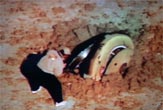
Credit: AP Photo/NASA/JPL
On February 15, 2013, the folks in Chelyabinsk Russia witnessed a rare event. That morning, an asteroid was seen streaking across the sky. It was more than just a light show. The shock wave damaged several buildings and nearly 1,500 people required medical attention (2 were serious injuries). Here are some interesting links: pictures video
Estimates of the initial mass of this asteroid were around 10,000 tons and measuring between 15-20 meters across. It broke into several fragments during its plunge into the atmosphere. The largest recovered piece (shown below) has a mass of 654 kg (1,442 pounds). It is estimated that something like this hits Earth every 100 years or so.
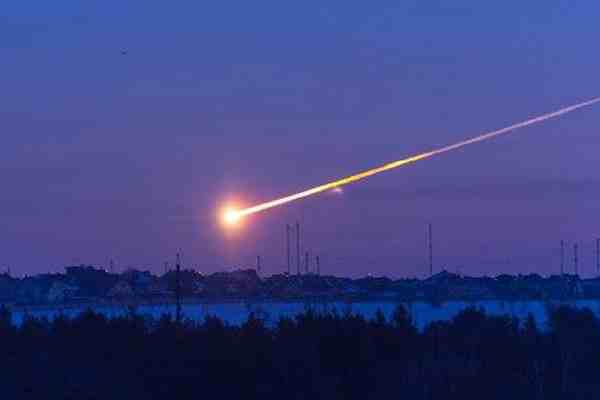

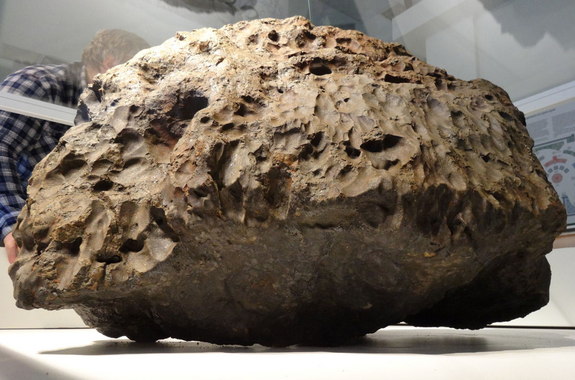
Credit space.com
Want to buy a rock from space? (I did) - click here. If not, just look over the prices ... some are not cheap.
Medium sized stuff ...
In 1908, in a remote area of Tunguska Siberia, an asteroid exploded in the atmosphere about 6 miles above the ground, ... knocking down trees 25 miles (from ground zero). Working backwards, scientists estimate that the initial asteroid was at least 80 meters in diameter. Luckily, this area was so remote that it is unlikely anyone was killed by this event. This was known as the Tunguska impact even though the only thing that hit the ground was a shock wave.

Image Credit: Smithsonian Institution
About 50,000 years ago, a much larger object hit the desert in Arizona. The Earth ran into an iron asteroid about 50 meters in diameter. Known as Meteor Crater, this impact site measures a mile in diameter.
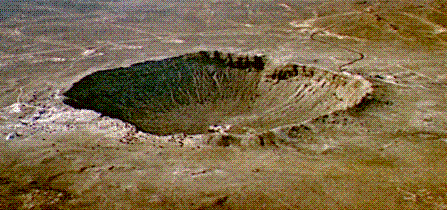
Credit NASA
Meteor Crater, AZ
About 120 impact sites have been identified on the surface of Earth. This small number reminds us that the actions of erosion and plate tectonics quickly hides evidence of earlier impacts. It also made us unaware of the potential damage an impacting rock can produce. That is, until a geologist named Gene Shoemaker came along. Gene Shoemaker wanted to become an Apollo astronaut (who would eventually land on the moon), ... but health problems eliminated him from the pool of candidates. He turned his attention to the geology of impacts. It was Shoemaker who identified the crater in Arizona as an impact site. Previously, it was believed that most craters of this type were produced by volcanic activity. By studying the results of underground nuclear tests, Shoemaker was able to convince most geologists that impacts have happened frequently in the past and will occur again in the future. He supported his claims by identifying several Earth approaching asteroids which represent potential threats to Earth. He tragically died in a car accident and as a tribute, his ashes crashed to the lunar surface in a probe sent by NASA to study the moon.
|
Gene Shoemaker (1928-1997) ... his ashes are on the moon |
One piece of Shoemaker - Levy 9 smashing into Jupiter Credit NASA |
The point was made in dramatic style in 1994 when Earth witnessed (for the first time), a comet smash into Jupiter. The comet, Shoemaker - Levy 9, was named for Caroline Shoemaker (Gene's wife) and David Levy. Soon afterwards, 21 fragments plunged into the giant planet, creating plumes the size of Earth. Lucky for us it hit Jupiter. This event inspired Hollywood to make Armageddon (which I hated) and Deep Impact (which I thought was OK).
What are your holiday plans for 2032?
In late 2024 astronomers discovered asteroid 2024 YR4 that (as of 2025) has a 2% chance of hitting Earth. This rock is about 100-300 ft across and could be labeled a "city killer". You can bet all eyes are on this one. Can we do something about it? Read on
Really big stuff ...
When chicken little cried "the sky is falling"
... she could be very correct! Most geologist now accept the idea
that an impact with Earth 65 million years ago, known as the
K/T
event or the Cretaceous–Paleogene (K–Pg) extinction event, lead to
the mass extinction of almost ¾ of all species (including the dinosaurs).
Another
smaller impact about 800,000 years ago
likely changed the human population on
Earth (killing about 10% of our early ancestors). This is based on the age of Australasian
tektites
(basically glass like objects made by flash heated/ejected soil). It's not a matter of if
it could happen again ... only when! If interested, click
here for a detailed account.
The geologic record shows that Earth periodically goes through mass extinction events which changes the course of life on the planet. About 65 million years ago, about ¾ of all life forms went extinct, ... including the dinosaurs. Geologists initially laughed off the claim (in 1980) by a father-son team of geologists (Luis & Walter Alvarez) that this event was caused by an impact from space, ... known as the K/T event. Their claim came from examining a thin layer of clay found around Earth dating to that time period. In this layer, they found high concentrations of the element iridium, which is rare in surface rocks but found in higher concentrations in meteorites. The impact, they claimed, would blow a blanket of dust into the atmosphere (which could last for years) in a scenario known as "nuclear winter". The collapse of the food chain would bring on the mass extinction. However, they were unable to provide an impact site. Later, studies from space showed that Earth was hit by a huge (10 km diameter) rock or comet, ... leaving a 180 km crater in the area of Chicxulub (in the Yucatan Peninsula). The date of the impact dates to 65 million years. Apparently, the smoking gun has been found. Geologists are still debating this idea. They point to the evidence that Earth also experienced volcanism on a mammoth scale about the same time. If so, the two events may not be unrelated. Did one event trigger the other (leaving Dino in the dust)?
Spot of the
K/T impact
Since Gene Shoemaker, scientists have begun to study Near Earth Objects (NEO's) in detail. The first step is to be aware of the potential threat, and then what action (if any) can be taken to alter the path of the asteroid or comet or destroy it before hitting Earth. For example, astronomers have long known an Earth approaching asteroid named 1036 Ganymed is a potential extinction event waiting to happen. It is about 4 times the size of the K/T object! Don't lose sleep .. it is not projected to hit anything soon.
Here is a list of other NEO's. As of 2022, it was about 30,000 objects discovered! Every once in a while we receive news of an object that could potentially hit Earth. Can we currently do anything if we find out a large object is about to slam into Earth? Not yet .... set to go! However, we have the technology (now) to deflect a potential Earth impactor (but not a delivery method) ... providing we have enough lead time to change its orbit. We are taking baby steps in that direction with project DART. This is the first attempt to change the course of an asteroid (that doesn't pose any threat) by smashing a probe directly on it. It is a bit like deflecting the course of a car by throwing a Ping-Pong ball at it, but if you have enough lead time and knowledge of the orbit of a potential killer asteroid, it doesn't take much to deflect it. DART worked! It exceeded the minimum expectations by a factor of 25x. That is why it is so important to know what is out there. More bad news ... after every extinction event in the earth's history, the top life forms of the food chain were taken off the map. Guess where we are? Have a nice day. ☺
So here is the deal. On one hand comets and asteroids may have seeded the early Earth with the building blocks of life (amino acids) and some water, but a future collision with a comet or asteroid could also take us out of the picture. It happened to the dinosaurs. Do you have car insurance? Of course you do .... to cover yourself should you have a (hopefully rare) collision. Isn't it worth our species to do the same things? I claim we have an ethical responsibility to invest in the ONLY natural catastrophe we can prevent.
©Jim Mihal 2004, 2014, 2019, 2020, 2022, 2025 - all rights reserved